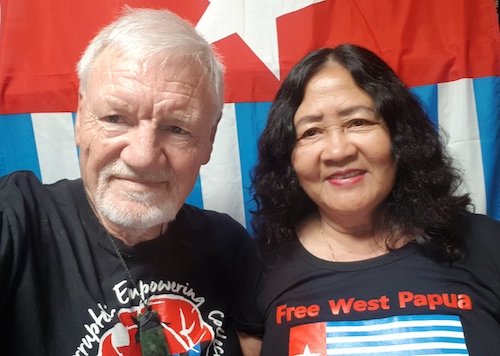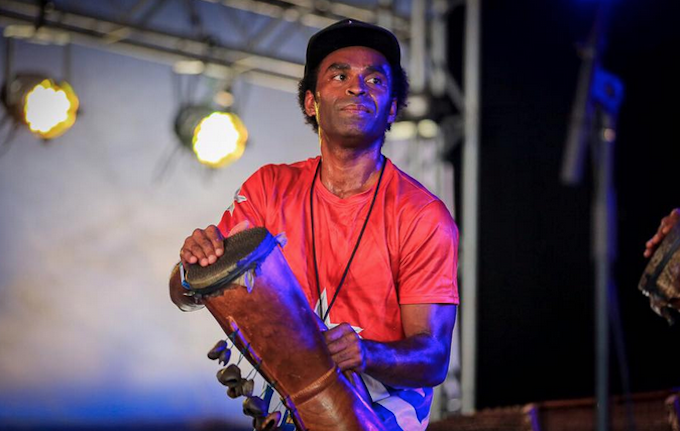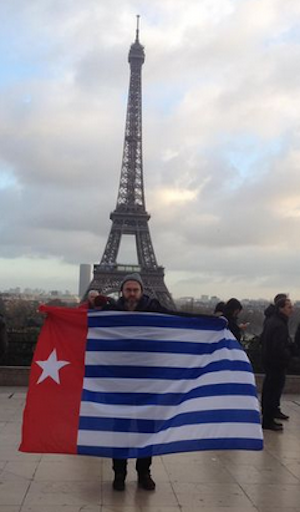
Dr Emalani Case speaking at the December 1 West Papuan virtual flag raising in
Wellington, New Zealand. IMAGE: APR screenshot
Asia Pacific Report newsdesk
FROM Auckland Tāmaki Makaurau in Aotearoa New Zealand to Paris, France, and from Wellington Te Whanganui-a-Tara to Jayapura and far beyond, thousands of people across the world today raised the Morning Star flag — banned by Indonesian authorities — in simple acts of defiance and solidarity with West Papuans.
They honoured the raising of the flag for the first time 60 years ago on 1 December 1961 as a powerful symbol of the long West Papua struggle for independence.
One of the first flag-raising events today was in Wellington where Peace Movement Aotearoa and Youngsolwara Pōneke launched a virtual ceremony online with most participants displaying the banned flag.
- READ MORE: Pressure mounts on Jakarta for dialogue, not brutal ‘war on Papua’
- Events to raise West Papua flag takes place across Pacific
 |
| Green MP Teanau Tuiono … indigenous solidarity for West Papuans. IMAGE: APR screenshot |
Hosted by Victoria University Pacific studies lecturer Dr Emalani Case, a Hawai’an, many young Pacific Islanders spoke of the indigenous struggle in West Papua and their hopes for eventual independence.
“Here in Aotearoa, we have the opportunity and the privilege of being able to raise the flag without being punished for it,” Dr Case said.
Two Green MPs — Teanau Tuiono and Eugenie Sage — were also among the “flag-raisers”, declaring their solidarity with the Papuan self-determination struggle.
Asia Pacific Report editor Dr David Robie and Del Abcede were among those who spoke.
In six decades of brutal civil conflict, hundreds of thousands of lives have been lost through combat and deprivation, and Indonesia has been criticised internationally for human rights abuses, reports Stefan Armbruster of SBS News.
In Australia, the Morning Star flew in activist Ronny Kareni’s adopted hometown of Canberra.
 |
| Asia Pacific Report’s Dr David Robie and Del Abcede … messages of West Papuan support. IMAGE: APR screenshot |
“It brings tears of joy to me because many Papuan lives, those who have gone before me, have shed blood or spent time in prison, or died just because of raising the Morning Star flag,” Kareni, the Australian representative of the United Liberation Movement for
West Papua (ULMWP), told SBS.
“Commemorating the 60th anniversary for me demonstrates hope and also the continued spirit in fighting for our right to self-determination and West Papua to be free from Indonesia’s brutal occupation.”
 |
| West
Papua’s Ronny Kareni … “Commemorating the 60th anniversary for me demonstrates hope and also the continued spirit in fighting for our right to self-determination.” IMAGE: SBS |
Indonesia’s diplomats regularly issue statements criticising the flag protests, including two years ago when the flag was raised at Sydney’s Leichhardt Town Hall, as “a symbol of separatism” that could be “misinterpreted to represent support from the Australian government”.
No response to questions about the flag’s 60th anniversary had been received by SBS News from the Indonesian embassy this year and community members and groups declined to comment.
“It’s a symbol of an aspiring independent state which would secede from the unitary Indonesian republic, so the flag itself isn’t particularly welcome within official Indonesian political discourse,” said Vedi Hadiz, an Indonesian citizen and director of the Asia Institute at the University of Melbourne.
“The raising of the flag is an expression of the grievances they hold against Indonesia for the way that economic and political governance and development has taken place over the last 60 years.
“But it’s really part of the job of Indonesian officials to make a counterpoint that West Papua is a legitimate part of the unitary republic.”
The history of the Morning Star
After World War II, a wave of decolonisation swept the globe.
The Netherlands reluctantly relinquished the Dutch East Indies in 1949, which became Indonesia, but held onto Dutch New Guinea, much to the chagrin of President Sukarno, who led the independence struggle.
In 1957 Sukarno began seizing the remaining Dutch assets and expelled 40,000 Dutch citizens, many of whom were evacuated to Australia, in large part over The Netherlands’ reluctance to hand over Dutch New Guinea.
The Dutch created the New Guinea Council of predominantly elected
Papuan representatives in 1961 and it declared a 10-year roadmap to
independence, adopted the Morning Star flag, the national anthem — “Hai Tanahku Papua” or “Oh My Land Papua” — and a coat-of-arms for a future state to be known as “West Papua”.
 |
| The Dutch and West Papuan flags fly side-by-side in 1961. IMAGE: SBS |
The West Papua flag was inspired by the red, white and blue of the Dutch but the design can hold different meanings for the traditional landowners.
“The five-pointed star has the cultural connection to the creation story, the seven blue lines represent the seven customary land groupings,” Kareni told SBS.
The red is now often cited as a tribute to the blood spilt fighting for independence.
Attending the 1961 inauguration were Britain, France, New Zealand and Australia — represented by the president of the Senate Sir Alister McMullin in full ceremonial attire — but the United States, after initially accepting an invitation, withdrew.
Morning Star raised for first time
The Morning Star flag was raised for the first time alongside
the Dutch one at a military parade in the capital Hollandia, now called
Jayapura, on December 1.
On December 19, President Sukarno began ordering military incursions into what he called “West Irian”, which saw thousands of soldiers parachute or land by sea ahead of battles they overwhelmingly lost.
With long supply lines on the other side of the world and waning international support, the Dutch sensed their time was up and signed the territory over to UN control in October 1962 under the “New York Agreement”, which abolished the symbols of a future West Papuan state, including the flag.
The UN handed control to Indonesia in May 1963 on condition it prepared the territory for a referendum on self-determination.
The so-called Act Of Free Choice referendum in 1969 saw the Indonesian military round up 1025 Papuan leaders who then voted unanimously to become part of Indonesia.
The outcome was accepted by the UN General Assembly, which failed to declare if the referendum complied with the “self-determination” requirements of the New York Agreement, and Dutch New Guinea was incorporated into Indonesia.
In 1971, the Free Papua Movement (OPM) declared the “republic of West Papua” with the Morning Star as its flag, which has gone on to become a potent binding symbol for the movement.
“It’s a milestone, 60 years, and we’re still waiting to freely sing the national anthem and freely fly the Morning Star flag so it’s very significant for us, ” Kareni said.
“We still continue to fight, to claim our rights and sovereignty of the land and people.”
 |
| The Morning Star flag in Paris, France. IMAGE: AWPA |










No comments:
Post a Comment